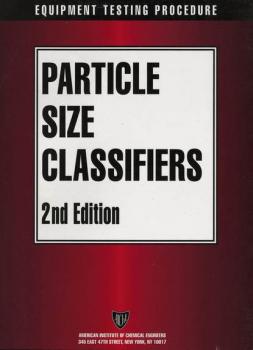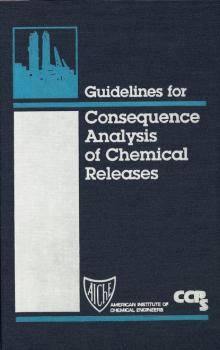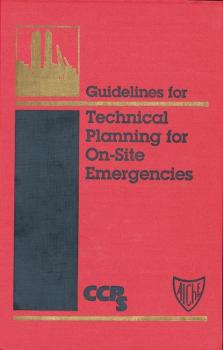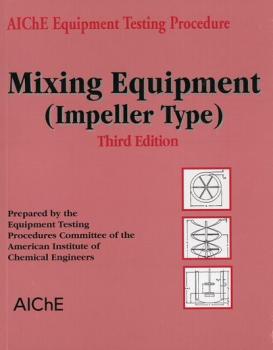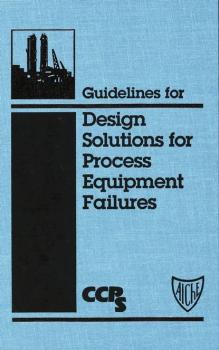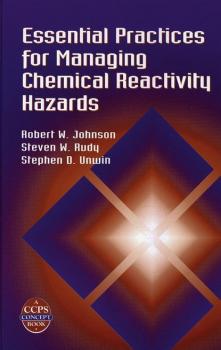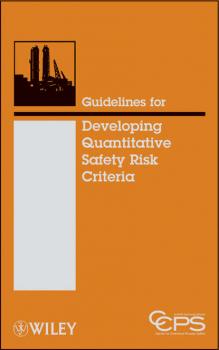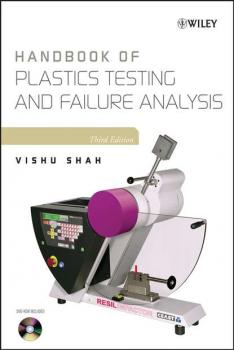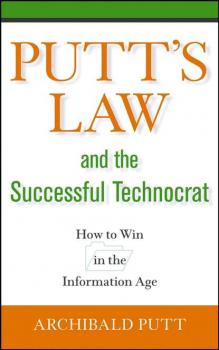ТОП просматриваемых книг сайта:
Техническая литература
Различные книги в жанре Техническая литература, доступные для чтения и скачиванияAIChE Equipment Testing Procedure - Particle Size Classifiers - American Institute of Chemical Engineers (AIChE)
Аннотация
This procedure offers complete methodologies for sampling and measuring particle streams and summarizes methods of particle size analysis. It also lists operating variables to be considered and measured. Although the procedure is intended specifically for particle classification equipment, many of the items are also relevant to particle collection devices.
Информация о книге
Автор произведения American Institute of Chemical Engineers (AIChE)
Guidelines for Consequence Analysis of Chemical Releases - CCPS (Center for Chemical Process Safety)
Аннотация
This Guidelines book provides technical information on how to conduct a consequence analysis to satisfy your company's needs and the EPA rules. It covers quantifying the size of a release, dispersion of vapor clouds to an endpoint concentration, outcomes for various types of explosions and fires, and the effect of the release on people and structures. Special Details: Includes CD-ROM with example problems worked using Excel and Quattro Pro. For use with Windows 95, 98, and NT.
Информация о книге
Автор произведения CCPS (Center for Chemical Process Safety)
Guidelines for Technical Planning for On-Site Emergencies - CCPS (Center for Chemical Process Safety)
Аннотация
Prevention, preparedness, response and recovery–the key components of emergency planning–form the major sections of this work. The book first describes PSM (Process Safety Management) as the key to prevention, then goes on to consider the main features of a preparedness program, including recognizing credible incidents, planning practical strategy to deal with these incidents, selecting necessary physical support systems and equipment, and developing a complete emergency response plan. The Response section presents the functions implemented during an actual emergency and concludes with a section on managing cleanup and restoration of operations. The many tables and figures include Sample Incident Command System Plans for both large and small organizations, OSHA and EPA regulations affecting planning, sample Fire Emergency Action Levels, HAZMAT Responder Levels, and OSHA Emergency Training Requirements.
Информация о книге
Автор произведения CCPS (Center for Chemical Process Safety)
AIChE Equipment Testing Procedure - Mixing Equipment (Impeller Type) - American Institute of Chemical Engineers (AIChE)
Аннотация
The latest edition of this industry-friendly guide to evaluating the performance of mixing equipment brings this traditional process operation into the 21st century. The book starts with basic definitions and terms, and goes to detail test planning and procedures, and computation and evaluation of results. Appendices offer a troubleshooting checklists, sample log.
Информация о книге
Автор произведения American Institute of Chemical Engineers (AIChE)
Guidelines for Design Solutions for Process Equipment Failures - CCPS (Center for Chemical Process Safety)
Аннотация
While there is no «perfect» solution or absolute zero risk, engineering design can significantly reduce risk potential in the CPI. In Guidelines for Design Solutions to Process Equipment Failures, industry experts offer their broad experience in identifying numerous solutions to the more common process equipment failures including inherent safer/passive, active, and procedural solutions, in decreasing order of robustness and reliability. The book challenges the engineer to identify opportunities for inherent and passive safety features early, and use a risk-based approach to process safety systems specification. The book is organized into three basic sections: 1) a technique for making risk-based design decisions; 2) potential failure scenarios for 10 major processing equipment categories; and 3) two worked examples showing how the techniques can be applied. The equipment categories covered are: vessels, reactors, mass transfer equipment, fluid transfer equipment, solids-fluid separators, solids handling and processing equipment, and piping and piping components. Special Details: Hardcover book plus 3.5" diskette for use in any word processing program with design solutions for use in PHAs.
Информация о книге
Автор произведения CCPS (Center for Chemical Process Safety)
Аннотация
In its recent investigation of chemical reactivity accidents, the US Chemical Safety Board noted a gap in technical guidance and regulatory coverage. This volume closes the gap in technical guidance, helping small and large companies alike identify, address, and manage chemical reactivity hazards. It guides the reader through an analysis of the potential for chemical reactivity accidents to help prevent fires, explosions, toxic chemical releases or chemical spills. This volume is applicable to processes at any scale and is particularly useful for chemists, safety managers, and engineers involved in scale-up. An enclosed CD-ROM provides portable checklists, analysis tools, and a list of additional references. Note: CD-ROM/DVD and other supplementary materials are not included as part of eBook file.
Guidelines for Developing Quantitative Safety Risk Criteria - CCPS (Center for Chemical Process Safety)
Аннотация
Written by a committee of safety professionals, this book creates a foundation document for the development and application of risk tolerance criteria Helps safety managers evaluate the frequency, severity and consequence of human injury Includes examples of risk tolerance criteria used by NASA, Earthquake Response teams and the International Maritime Organization, amongst others Helps achieve consistency in risk-based decision-making Reduces potential liabilities in the use of quantitative risk tolerance criteria through reference to an industry guidance document
Информация о книге
Автор произведения CCPS (Center for Chemical Process Safety)
Аннотация
Current oxide nanomaterials knowledge to draw from and build on Synthesis, Properties, and Applications of Oxide Nanomaterials summarizes the existing knowledge in oxide-based materials research. It gives researchers one comprehensive resource that consolidates general theoretical knowledge alongside practical applications. Organized by topic for easy access, this reference: * Covers the fundamental science, synthesis, characterization, physicochemical properties, and applications of oxide nanomaterials * Explains the fundamental aspects (quantum-mechanical and thermodynamic) that determine the behavior and growth mode of nanostructured oxides * Examines synthetic procedures using top-down and bottom-up fabrication technologies involving liquid-solid or gas-solid transformations * Discusses the sophisticated experimental techniques and state-of-the-art theory used to characterize the structural and electronic properties of nanostructured oxides * Describes applications such as sorbents, sensors, ceramic materials, electrochemical and photochemical devices, and catalysts for reducing environmental pollution, transforming hydrocarbons, and producing hydrogen With its combination of theory and real-world applications plus extensive bibliographic references, Synthesis, Properties, and Applications of Oxide Nanomaterials consolidates a wealth of current, complex information in one volume for practicing chemists, physicists, and materials scientists, and for engineers and researchers in government, industry, and academia. It's also an outstanding reference for graduate students in chemistry, chemical engineering, physics, and materials science.
Аннотация
Written in easy-to-read and -use format, this book updates and revises its bestselling predecessor to become the most complete, comprehensive resource on plastics testing. This book has an emphasis on significance of test methods and interpretation of results. The book covers all aspects of plastics testing, failure analysis, and quality assurance – including chapters on identification analysis, failure analysis, and case studies. The book concludes with a substantial appendix with useful data, charts and tables for ready reference. Note: CD-ROM/DVD and other supplementary materials are not included as part of eBook file.
Аннотация
Technology is dominated by two types of people: those who understand what they do not manage, and those who manage what they do not understand. —Putt's Law Early Praise for Putt's Law and the Successful Technocrat: «This is management writing the way it ought to be. Think Dilbert, but with a very big brain. Read it and weep. Or laugh, depending on your current job situation.» —Spectral Lines, IEEE Spectrum, April 2006 «It's a classic. It reads at first like humor, but one eventually realizes that it's all true. The first edition changed my life. I loaned my copy to a subordinate at IBM, and he didn't return it to me until he was my boss.» —Dave Thompson, PhD, IBM Fellow (retired), Member National Academy of Engineering, and IEEE Fellow «Putt's humor ranges from sharp to whimsical and is always on target. Readers will be reminded of many personal experiences and of lessons in life they wish they had learned earlier in their careers.» —Eric Herz, former IEEE executive director and general manager «Anyone who thinks 'engineering management' is an oxymoron needs to read this terrific book – then they will know.» —Norman R. Augustine, author of Augustine's Laws and retired Chairman & CEO of Lockheed Martin Corporation Putt's Law is as true today as it was when techno-everyman Archibald Putt first stated it. Now, in Putt's Law and the Successful Technocrat: How to Win in the Information Age, Putt is back with the unvarnished truth about success in the modern, technology-driven organization. As you learn the real rules of the technology world, you'll meet such characters as the successful technocrat, Dr. I. M. Sharp. You'll find out how he wrangles career victories from corporate failures, nearly bankrupting the firm with his projects while somehow emerging the hero. You'll also meet such unfortunates as Roger Proofsworthy, top-level perfectionist yet low in the hierarchy, and come to understand how he assiduously preserves his spot near the bottom of the totem pole. Whether you work in business, IT, or are a freelance technocrat, you'll want to study Putt's hard-won wisdom and laugh—all the way to the bank!

